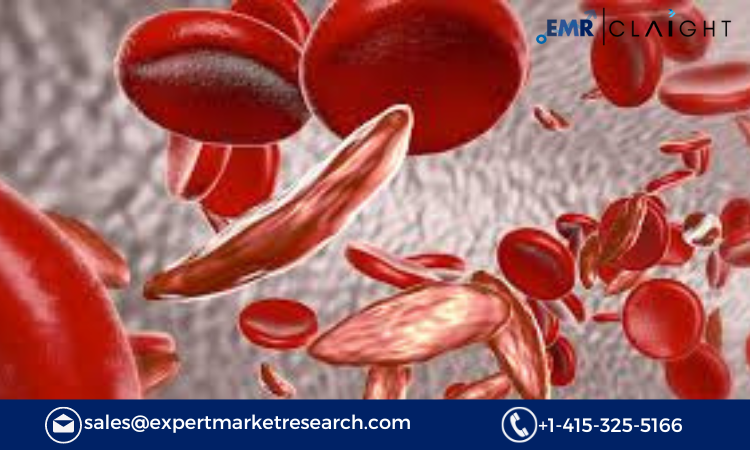North America Hemoglobinopathies Market Size, Share, Trends, Report 2032
Hemoglobinopathies are a group of inherited disorders affecting the structure or production of hemoglobin, the protein in red blood cells responsible for oxygen transport. The two most prevalent hemoglobinopathies are sickle cell anemia and thalassemia. These conditions pose significant public health challenges due to their chronic nature, potential complications, and impact on patients’ quality of life. In North America, the market for hemoglobinopathies is experiencing growth driven by various factors, including demographic shifts, improved healthcare infrastructure, and technological advancements in treatment and diagnostics.
Market Overview
2.1. Market Size and Growth Rate
The North America hemoglobinopathies market is anticipated to grow at a CAGR of 5.10% from 2024 to 2032. This steady growth is underpinned by the rising incidence of hemoglobin disorders and the region’s robust healthcare system, which facilitates the development and adoption of innovative treatments and diagnostic tools.
2.2. Forecast Period: 2024-2032
The forecast period of 2024-2032 encompasses significant developments in medical research, policy initiatives, and market dynamics. During this period, advancements in biotechnology and increased awareness about hemoglobinopathies are expected to play crucial roles in shaping the market landscape.
Drivers of Market Growth
Several factors contribute to the projected growth of the hemoglobinopathies market in North America. These drivers can be categorized into the increasing prevalence of hemoglobin disorders, advancements in treatment options, and progress in diagnostic technologies.
3.1. Increasing Prevalence of Hemoglobinopathies
3.1.1. Sickle Cell Anemia
Sickle cell anemia is a genetic blood disorder characterized by the production of abnormal hemoglobin, leading to distorted (sickle-shaped) red blood cells. These misshapen cells can block blood flow, causing pain, organ damage, and increased risk of infections. In North America, the prevalence of sickle cell anemia is notably high among African American populations, as well as other minority groups. According to the Centers for Disease Control and Prevention (CDC), approximately 100,000 Americans are affected by sickle cell disease. The rising awareness and improved diagnostic capabilities have led to better detection rates, thereby increasing the reported prevalence and fueling market growth.
3.1.2. Thalassemia
Thalassemia is another significant hemoglobinopathy, involving the reduced production of hemoglobin chains, which results in anemia and other health complications. The condition is particularly prevalent among individuals of Mediterranean, Middle Eastern, and Southeast Asian descent. In North America, immigration patterns have contributed to a diverse patient population, thereby increasing the incidence of thalassemia. The chronic nature of thalassemia, which often requires regular blood transfusions and iron chelation therapy, underscores the need for ongoing treatment solutions and supports market expansion.
3.2. Advancements in Treatment
Innovations in treatment methodologies have significantly impacted the hemoglobinopathies market, offering improved patient outcomes and driving market growth.
3.2.1. Gene Therapy
Gene therapy represents a groundbreaking advancement in the treatment of hemoglobinopathies. By targeting the genetic root causes of disorders like sickle cell anemia and thalassemia, gene therapy aims to correct or replace defective genes, potentially offering a cure. The FDA approval of treatments such as Zynteglo for beta-thalassemia has set a precedent for further innovations in this field. As research progresses and more gene therapies enter the clinical pipeline, their adoption is expected to surge, propelling market growth.
3.2.2. Iron Chelation Therapies
Iron chelation therapy is essential for managing iron overload in patients receiving frequent blood transfusions, a common treatment for thalassemia. Advancements in chelation agents, such as deferasirox and deferiprone, have improved patient compliance and reduced side effects. The development of oral chelators, which are more convenient than traditional intravenous methods, has enhanced the quality of life for patients, thereby increasing the demand for these therapies in the North American market.
3.2.3. Bone Marrow Transplants
Bone marrow or hematopoietic stem cell transplants (HSCT) offer another potential cure for hemoglobinopathies. Advances in transplant techniques, donor matching, and post-transplant care have increased the success rates of HSCT, making it a viable option for more patients. The growing availability of matched unrelated donors and the use of reduced-intensity conditioning regimens have further expanded the eligibility of patients for this treatment, contributing to market growth.
3.3. Progress in Diagnostic Technologies
Early and accurate diagnosis of hemoglobinopathies is crucial for effective disease management and treatment planning. Progress in diagnostic technologies has enhanced the ability to detect these disorders at various stages, thereby driving market expansion.
3.3.1. Genetic Screening
Genetic screening technologies, including next-generation sequencing (NGS) and polymerase chain reaction (PCR)-based assays, have revolutionized the diagnosis of hemoglobinopathies. These advanced diagnostic tools enable precise identification of genetic mutations responsible for disorders like sickle cell anemia and thalassemia. Prenatal screening and carrier testing have become more accessible, allowing for early intervention and informed family planning decisions. The integration of genetic screening into routine healthcare practices has increased the detection rates, thereby augmenting the demand for diagnostic services in the North American market.
3.3.2. Advanced Imaging Techniques
Advanced imaging techniques, such as magnetic resonance imaging (MRI) and ultrasound, play a significant role in assessing organ damage and complications arising from hemoglobinopathies. These technologies facilitate the monitoring of disease progression and the effectiveness of treatment regimens. Innovations in imaging, including non-invasive methods and higher resolution imaging, have improved the accuracy and reliability of diagnoses, thereby enhancing patient management and supporting market growth.
Get a Free Sample Report with Table of Contents
Market Segmentation
Understanding the hemoglobinopathies market requires an analysis of various segments based on disease type, treatment modalities, and diagnostic tools. This segmentation provides insights into specific areas driving market demand and identifies opportunities for stakeholders.
4.1. By Disease Type
- Sickle Cell Anemia: The largest segment within the hemoglobinopathies market, driven by high prevalence rates and ongoing research into curative treatments.
- Thalassemia: A significant segment fueled by the chronic nature of the disease and the necessity for continuous treatment options.
4.2. By Treatment Modalities
- Gene Therapy: A rapidly growing segment with high investment in research and development.
- Iron Chelation Therapy: Steady growth due to the essential nature of managing iron overload in thalassemia patients.
- Bone Marrow Transplants: Increasing adoption as a potential cure, though limited by donor availability and transplant-related risks.
- Supportive Care and Other Treatments: Includes blood transfusions, pain management, and other symptomatic treatments.
4.3. By Diagnostic Tools
- Genetic Screening: Expanding rapidly with advancements in molecular diagnostics.
- Imaging Techniques: Growing due to the need for monitoring disease complications.
- Laboratory Diagnostic Tests: Traditional methods like complete blood count (CBC) and hemoglobin electrophoresis continue to play a crucial role.
Regional Insights
North America, encompassing the United States and Canada, dominates the hemoglobinopathies market due to its advanced healthcare infrastructure, significant investment in medical research, and high prevalence of hemoglobin disorders among certain demographics. The United States, in particular, leads the market with substantial healthcare expenditure, widespread access to advanced treatments, and a high rate of genetic screening programs. Canada follows closely, benefiting from its universal healthcare system and focus on innovative healthcare solutions.
United States
The U.S. market is characterized by robust pharmaceutical and biotechnology sectors, which drive the development of novel therapies and diagnostics. Regulatory support from agencies like the FDA facilitates the approval and commercialization of new treatments. Additionally, strong patient advocacy groups and increased awareness campaigns contribute to higher diagnosis rates and better disease management.
Canada
Canada’s healthcare system emphasizes equitable access to medical services, which supports the adoption of advanced treatments and diagnostic tools across the population. Collaborative research initiatives between government bodies and private entities foster innovation in hemoglobinopathy management, positioning Canada as a key player in the North American market.
Challenges and Restraints
Despite the promising growth prospects, the North America hemoglobinopathies market faces several challenges that could impede its expansion:
High Treatment Costs
Advanced treatments such as gene therapy and bone marrow transplants are expensive, limiting accessibility for some patients. The high cost of these therapies can strain healthcare budgets and insurance systems, potentially slowing market growth.
Limited Donor Availability
Bone marrow transplants, while effective, are constrained by the availability of suitable donors. The scarcity of matched donors, especially for minority populations, poses a significant challenge in the widespread adoption of HSCT.
Regulatory Hurdles
The approval process for novel therapies is stringent, requiring extensive clinical trials and regulatory scrutiny. Delays in approval can hinder the timely introduction of new treatments to the market.
Patient Compliance
Chronic nature of hemoglobinopathies necessitates long-term treatment adherence. Patient non-compliance with treatment regimens, particularly for therapies requiring frequent administration, can adversely affect outcomes and market dynamics.
Opportunities
Despite the challenges, several opportunities exist to further propel the North America hemoglobinopathies market:
Personalized Medicine
Advancements in genomics and personalized medicine offer tailored treatment approaches based on individual genetic profiles. Personalized therapies can enhance treatment efficacy and minimize adverse effects, attracting greater investment and adoption.
Emerging Technologies
Integration of artificial intelligence (AI) and machine learning in diagnostics and treatment planning can revolutionize hemoglobinopathy management. These technologies can improve diagnostic accuracy, predict disease progression, and optimize treatment protocols.
Expansion of Genetic Screening Programs
Increasing the coverage and accessibility of genetic screening programs, including newborn screening, can lead to earlier diagnosis and intervention, improving patient outcomes and expanding the market for diagnostic tools.
Strategic Partnerships
Collaborations between pharmaceutical companies, research institutions, and healthcare providers can accelerate the development and commercialization of innovative therapies. Strategic partnerships can also facilitate knowledge sharing and resource optimization, driving market growth.






